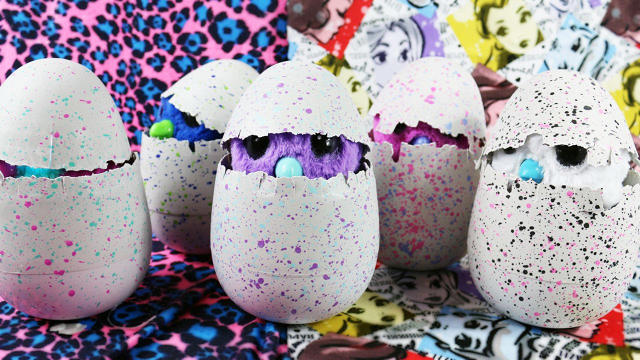Santa’s Sack Will Overflow With Tech-Enhanced Toys This Holiday Season
When I asked my nephew which toys his peers discuss on the playground, his response was rather illuminating.
“Kids like toys they can destroy, they can build, they can control,” he said.
My nephew is 9. But he is on to something. U.S. toy sales grew by 6% from January through September 2016, with substantial growth in higher-priced items for drones and robotic toys. These are products you can indeed build, control, and destroy with a few remote-controlled buttons or the right coding.
Interactive toys such as Hatchimals, a fuzzy animal that “hatches” from an egg, and the Star Wars Sphero App Controlled BB-8 are among this holiday season’s top five toys, according to Juli Lennett, industry analyst for NPD Group.
In our hyper-connected culture, Santa’s wish list is mirroring the gadgetry of the adult world. “Those things are naturally going to play down into toys,” Lennett says. “We’ll see more and more of that in the future.”
Last year, children were introduced to Hello Barbie ($74), an interactive doll that uses voice recognition technology and Wi-Fi to carry on conversations. Topics include favorite school subjects, family dynamics, and ya know, dollhouse diary confessions. It’s as if Siri merged with an overenthusiastic babysitter.
Hello Barbie was met with heavy criticism, but Lennett believes the doll was ahead of its time. In coming years, we will likely see similar products hitting the market, in addition to augmented reality drones and home automation personal assistant toys for children.
This season, the hot toys are not as controversial, but they are innovative in unassuming ways. Mattel released the high-tech Barbie Hello Dreamhouse ($299.99), the world’s first smart dollhouse. Its floor sensors recognize where Barbie and her friends are in the home, and embedded speech recognition controls elements like the slide and elevator.
Chip by Wowwee ($163) is an AI-powered robotic dog that is hyper aware of its owner’s whereabouts and reacts to his or her voice and actions. The mobile pooch plays fetch, barks, cries, and when low on power, knows to scuffle back to its power base for a “nap.” The more you interact with it, the more it adjusts to your personality. If you play fetch frequently, Chip will start nudging you to throw his ball.

“No one’s ever done that—where the robot dog knows where you are, knows about you, and knows about its own things, like its ball and bed and can react accordingly,” says Davin Sufer, CTO of WowWee.
Similarly, Cozmo from Anki ($179.99) is the closest robot yet to a real-life Wall-E. With 1.2 million lines of code, this little guy pulls at your heartstrings with his adorable expressions, movements, and ability to read human emotions and his environment. Anki instilled Cozmi with an “emotion engine,” which evolves the more you play with him. He’ll light up when he sees a familiar face and might sulk if you beat him at a game. It’s no surprise it was created by former Pixar employees.
“Just don’t call him a toy,” reads the Anki website. “He’s a supercomputer on treads. And he’s fun on a whole new level.”
Cozmo is selling remarkably well at top retailers such as Amazon, Toys “R” Us, and Best Buy. According to Anki’s press manager, Andrew Cha, the company is expecting the not-toy to sell out well before the holidays.
“With ability to roll out new features to Cozmo via software updates, consumers are recognizing that our robot far exceeds the shelf life of an average toy,” Cha says via email.
Some old favorites have also made a comeback, albeit with a modern twist. The Hot Wheels AI Racing Starter Set ($99.99) from Mattel uses artificial intelligence to guide cars around the track independently.
Meanwhile, Furby Connect ($99) looks and sounds like the Furby you knew from 1998, but the more gibberish-speaking cutie is now Bluetooth-enabled and syncs with the Furby Connect World app. He still responds to touch, but he’s more expressive and sports a light-up antenna that glows when there’s an app update. Kids can develop a relationship with their Furby Connect via trending videos, music, and even pop culture news.
“Over the years, kids and Furby fans alike told us they wanted a Furby they could interact with in more ways, so we created the technology that makes that possible,” said Samantha Lomow, senior vice president, Hasbro Brands. “Furby will react to new entertainment in the app in real time just like any other friend.”
Similarly, Torch the FurReal Friends pet dragon from Hasbro ($79.99) is an advanced animatronic toy that responds to touch with motions and more than 50 different sounds. The friendly reptile is addicted to fake plastic marshmallows, which can be “toasted” by his breath. He sorta looks like a baby Falkor if The Neverending Story character took a hit from a joint.
“Dragons are dominating pop culture, appearing everywhere from TV and movies to games, apps, and more,” said Hasbro’s Lomow. “We’re tapping into this trend and making the dream of owning a baby dragon a reality for kids.”
The most coveted product this season is Hatchimals by Spin Master ($69.99), which is already sold out in most retailers and going for triple its price on eBay. The interactive oversized egg hatches to reveal a surprise fuzzy animatronic baby toy that, like the Tamagotchi, requires constant attention to thrive. Kids teach them to walk, talk, and more as they raise them from hatch to adulthood. What makes this item particularly unique is that it was partially inspired by a current craze: unboxing videos on YouTube.
Children still discover the latest in toys and games via their friends, Saturday afternoon TV ads, and toy catalogs. But more and more, kids are turning to social media to discover what’s new in the market.
“They know everything from the friends—friends are a huge influence,” says Liz Gumbinner, editor-in-chief of the popular digital parenting network Cool Moms Picks. But the digital space is just as potent. “When my kids say, ‘Let’s watch a show,’ I think, ‘Oh good family time.’ I go to turn on the TV and they’re all on their screens independently.”

Spin Master understood that the allure of those unboxing videos is the anticipation of unveiling a surprise. Hatchimals capitalized on this by keeping the product’s species a secret, tucked inside an egg that the child will only “hatch” through touch and sound, which the toy calls “loving.”
“What would be more magical than unboxing your own toy?” says Ronnen Harary, co-chief executive officer and cofounder of Spin Master. “You’ve never had a character that’s in an egg and has the propensity through an incredible mechanism to peck it way out over time. As soon as you take it out of its box, it comes alive. It speaks to you and has a personality.”
Getting Into The Holiday Spirit
There are other hot trends—such as experiential toys, games, and puzzles—in the market, but the robotic/connected sector is growing at a rapid rate. This is partially because brands are expanding to younger audiences and broadening to more educational products. What was once marketed to children 6 and up, is now starting to trickle down to even toddlers.
“Where the magic really happens is where toymakers put technology into products that give them greater play value,” says Richard Barry, executive vice president, global chief merchandising officer of Toys”R” Us, Inc.
For example, the Kano Build Your Own Computer Kit ($149.99) is a simple kit that uses games to teach kids 6 and up how to code. Fisher Price’s Code-A-Pillar ($39.99) helps preschoolers code with eight pieces of a shiny caterpillar that snap together. Each segment can be joined to another and therefore sequenced to move a certain way. It’s on the Toys “R” Us Holiday Hot Toy List, which reflects the most sought-after items of the year.
“I’m seeing those toys starting earlier and earlier,” Gumbinner says, mentioning similar coding toys like Wonder Workshop’s Dot and Dash robots ($149.99), which helps kindergarten-age kids learn basic coding through an iPad companion app.
As NPD’s Lennett explains, this plays in part with American parents trying to give their kids a leg up on technology, even while still in diapers. “Parents want to make sure their kids are keeping up with the Joneses,” she says.
That includes both boys and girls. The past year has seen a growth in STEM toys marketing to girls in an effort to “break the princess mold,” as Gumbinner puts it. What were once considered traditionally male categories are now getting a (literal) pink makeover. This includes Mattel’s Hoverboard Barbie drone ($59.99) and Jewelbots bracelets ($69), which are bright, programmable friendship bracelets.
Some parents are willing to splurge on these high-tech items that are pricier than your average Candyland. A price point above $70 was one of the biggest sectors last year and is slated to continue for this November and December.
“Parents are definitely willing to spend money on that one big toy,” Lennett says. “They one want to have that ‘aha’ moment on Christmas.” This has been true for decades, of course, but with big-ticket tech gadgets, the prices are getting heftier.
Still, not every present under the tree has to be tech. Puzzles, multi-generational games, as well as outdoor sports gear are also selling well. Parents are striving for balance, recognizing that eschewing electronic devices altogether will only result in customer service complaints aimed at the North Pole.
“They want to provide kids with opportunities that allow them to use screen time educationally, but we also want them to get outside,” Gumbinner says. “Screen time isn’t going away so the best thing we can do is look for balance.”
The Kids Are Alright
This year’s top tech toys hail from a wide range of startups and big manufacturers, as well as small innovative companies partnering with big franchises, such as the Star Wars BB-8 droid made by Sphero. Classics like Stormtrooper action figures and Nerf Blasters are also getting a connected makeover. “There’s no doubt the market is going to grow for products that have technology built into them,” Toys “R” Us’s Barry says.
When presented with all these toy options, my nephew admitted he still prefers Legos. He is an avid collector.
But when I showed him a video of Brixo, which are essentially electronic building blocks infused with sensors, motors, and connected apps, his eyes lit up.
“I love it,” he said, referencing a Big Ben London LEGO set he would like even more if it could actually tell time. “I wish my toys could do more.”
Fast Company , Read Full Story
(57)














